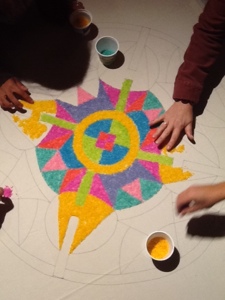The first workshop I attended connected nicely with the work that Katie Babic and I are doing with a small group fifth and sixth graders around mindfulness. This workshop was lead by artist Gowri Savoor. She taught about the Indian art of Rangoli, which is traditionally a mandala-type pattern created from chalk dust on the ground during the holiday of Diwali. We created our own Rangoli designs using colored rice. The process is meditative and calming and the art is ephemeral- it only lasts for a short period of time. I enjoyed working with other people to create a group Rangoli design. Click here for more examples of Rangoli art.

The second workshop I attended was about the Panamanian art of Molas. Click here for more information about Molas. During this workshop, we used colored felt to create our own Molas.


Spending a day at Shelburne Museum in the fall in such a treat! In
addition to enjoying the beautiful grounds and exhibits, I visited the
European Art collection to see paintings by Monet, Cassatt, Manet and
Degas. It is quite an experience to be up close and personal with such
famous works of art!
I also enjoyed an exhibit of contemporary and mostly local art called "Eyes on the Land." This is a collection of works that explore how our landscape can be viewed using a variety of arts media. This display is a collaboration between the Vermont Land Trust and the Shelburne Museum. 






No comments:
Post a Comment